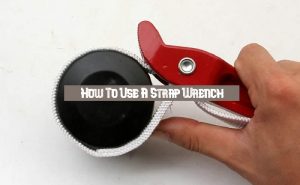 A wrench is probably one of the most common tools anyone would have in their toolbox. Wrenches are usually bought in sets of different sizes.
A wrench is probably one of the most common tools anyone would have in their toolbox. Wrenches are usually bought in sets of different sizes.
Some wrenches are made a bit differently and have to be bought separately. Examples of such wrenches would be the adjustable wrench, pipe wrench, socket wrench, crowfoot wrench, torque wrench, etc.
Another interesting wrench is the strap wrench, which doesn’t look like the common wrenches we use. This wrench is pretty rare, and not everyone keeps one in their set of tools.
But if you do have one, you should also know how to use it. Right now, we’ll help you understand how to use a strap wrench in the simplest way possible.
How To Use A Strap Wrench
There are different types of strap wrenches, and they all can be used when you are doing tasks related to plumbing, carpentry, etc.
People usually use tools like channel lock pliers or crescent wrenches to do plumbing work, but you can easily replace those tools with a strap wrench. That is because the strap watch is a very adjustable and versatile tool.
You can use the rubber or polyester strap on the wrench as a grip so that you can handle turning different parts of the pipes without causing any damages or scratches to the pipes. This is because of the control you have on the wrench from your strong gripping.
There may be different types of strap wrenches, but it does not mean you can just buy anyone and use it for any kind of task. There are certain tasks that the strap wrench is ideal for.
Tasks involving plumbing fixtures, loosening or tightening of pipes, screwing on locks on doors, fitting doorknobs, etc. You can even use the strap wrench for opening jars or bottles of food items.
Even though the strap wrench may be an unconventional tool and not used that vastly, it is still not that hard to use. There are some simple steps to use the strap wrench, and they are given below:
Step 1: Preparation
Before you start anything, you have to cover up the item you are about to work on. Whether they are pipes, doorknobs, or any other fixture or fitting, you need to cover the item you are about to tighten or loosen. You can use the straps to cover the item up.
There are some indicators you will find on the body of the strap wrench. These indicators will look like arrows most likely. They are there to tell you the direction in which the strap wrench needs to be faced. This depends on the direction you are about to turn your fixtures or fittings.
According to the indicators, you can tighten the strap of the wrench around that fixture or fitting. This way, you will have the perfect angle to make your adjustments on the item you are working on because you will be able to apply the right amount of pressure needed from that angle.
Step 2: Tightening
Once you have prepared the item, you will be using your wrench on, and after you have understood the instructions of the strap wrench indicators, you can begin tightening the fittings of the item.
The strap must be already covering the item in the right direction by now. This way, the strap will firmly be attached to the fittings of the item from the right angle.
To tighten the strap, all you need to do is pull hard. Depending on the model, you may find some ridges on the straps. If you need to use them, you can do so according to the instructions on how they are supposed to be used.
Step 3: Turning
Now that you have firmly wrapped the strap on the fittings of your item by tightening the strap on it, you can twist or turn it in the direction you need for the purpose of tightening or loosening the fittings.
If you have a strap wrench that has a handle on it, then you can use that for easy operating. You need to hold onto that handle firmly and then twist or turn the wrench on the fitting to either side to tighten or loosen it.
The fittings will start to move, but you need to remember this is only possible because you are applying your own strength here to create the force needed to twist. The wrench itself is not strong enough to handle creating most of the pressure here.
Step 4: Finishing Up
After exerting all that energy, you will finally be able to tighten or loosen the fittings or fixtures to a desirable point. There may be a time when you feel stuck with your strap wrench and that it does not feel like it is moving the way it should be.
The reason may be because the piece you are working on is probably rusted or damaged. You can either try replacing the fittings or try applying some sort of lubricant solvent to soften the fittings a bit so that you can twist it with your wrench.
Final Words
Hopefully, now you will have a better understanding of the need for strap wrenches and how to use a strap wrench in the right method for the right tasks.
It has its own benefits to those sorts of tasks that can not be performed with other types of wrenches or other tools. A strap wrench is a versatile tool that comes in different sizes and adjusts to almost any kind of surface or material.